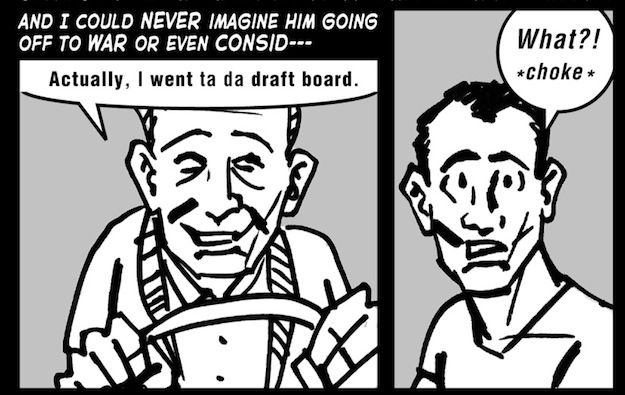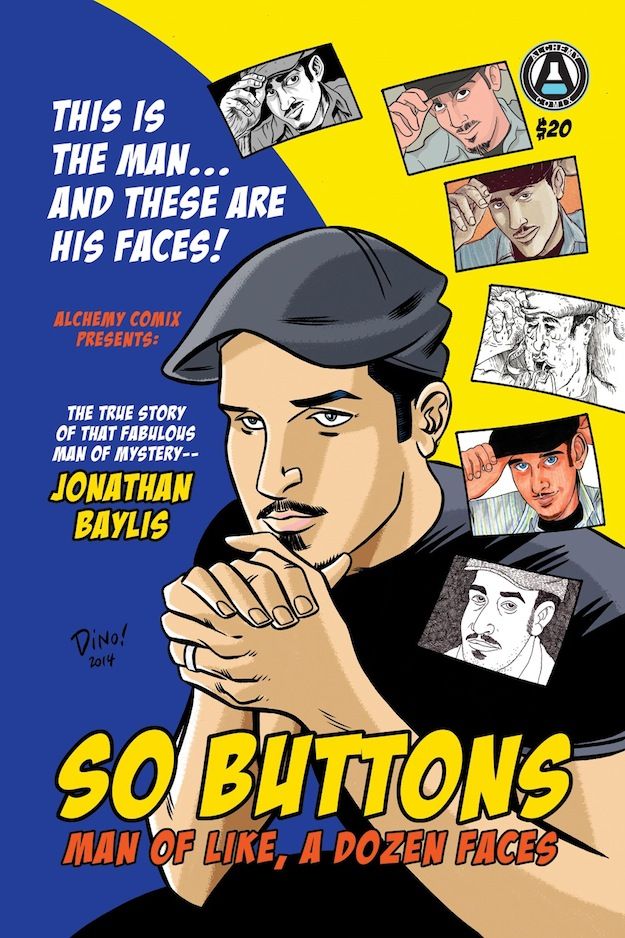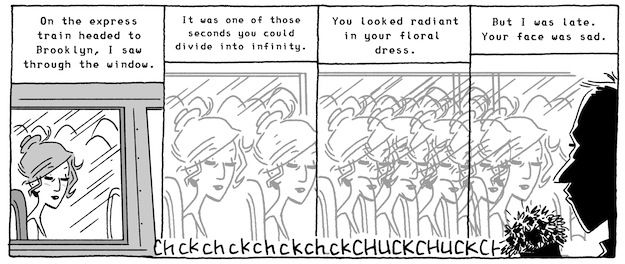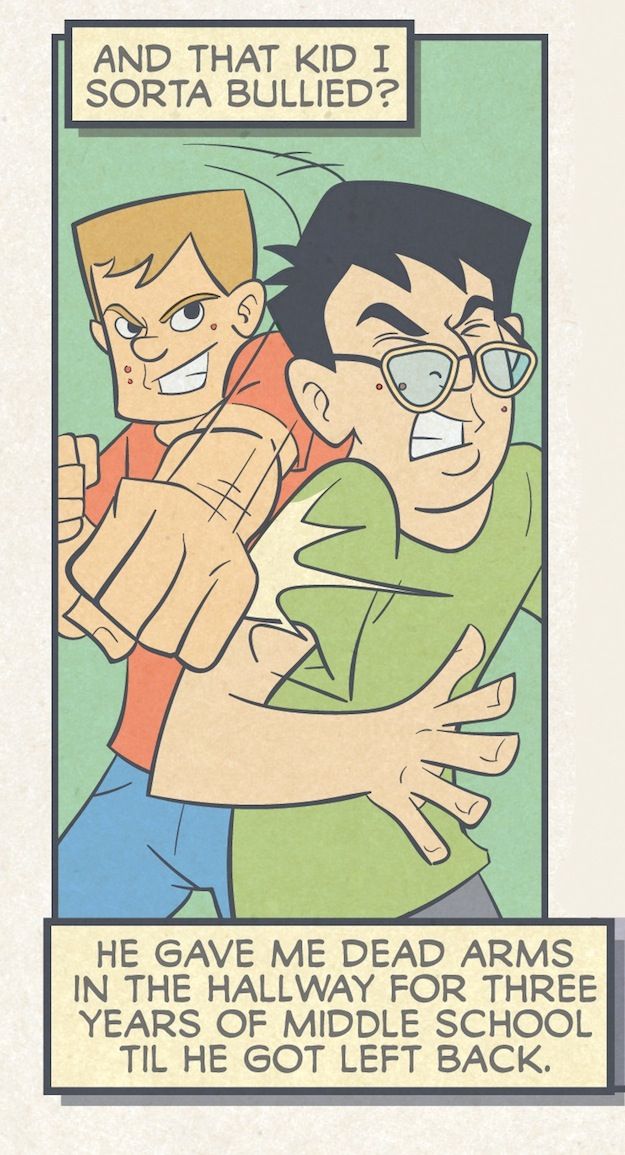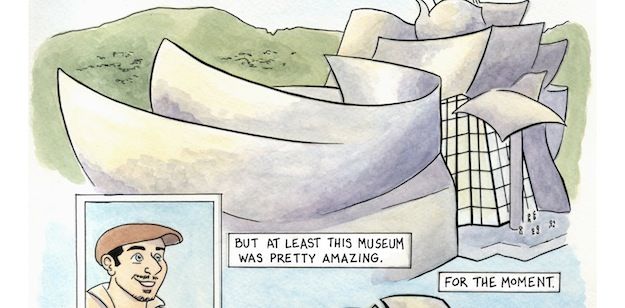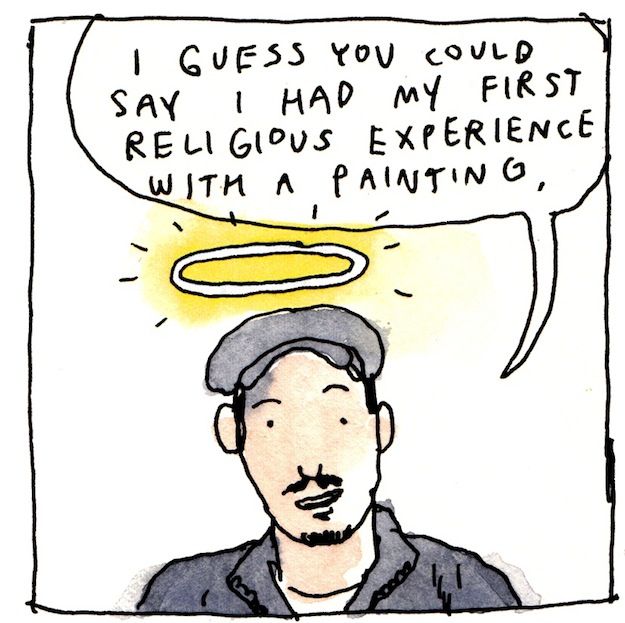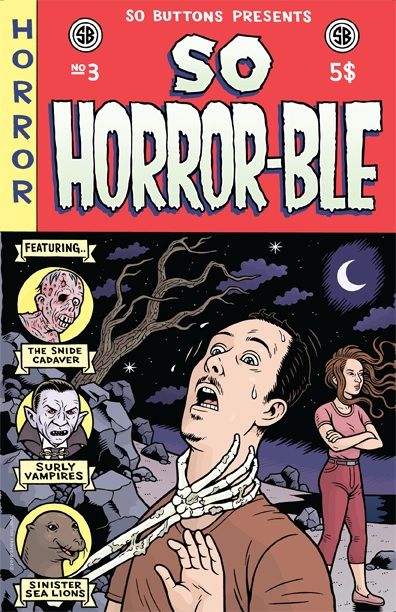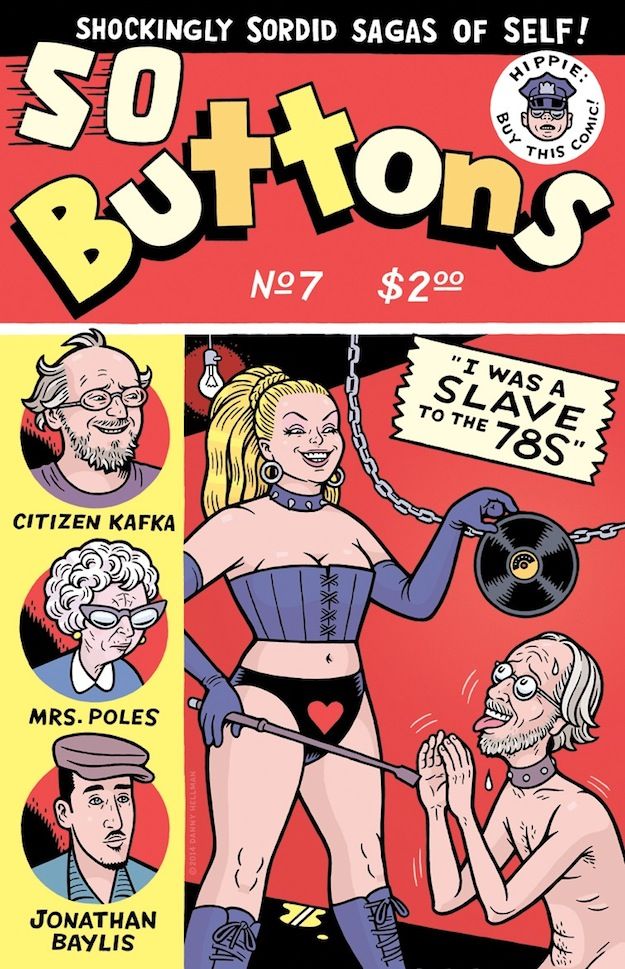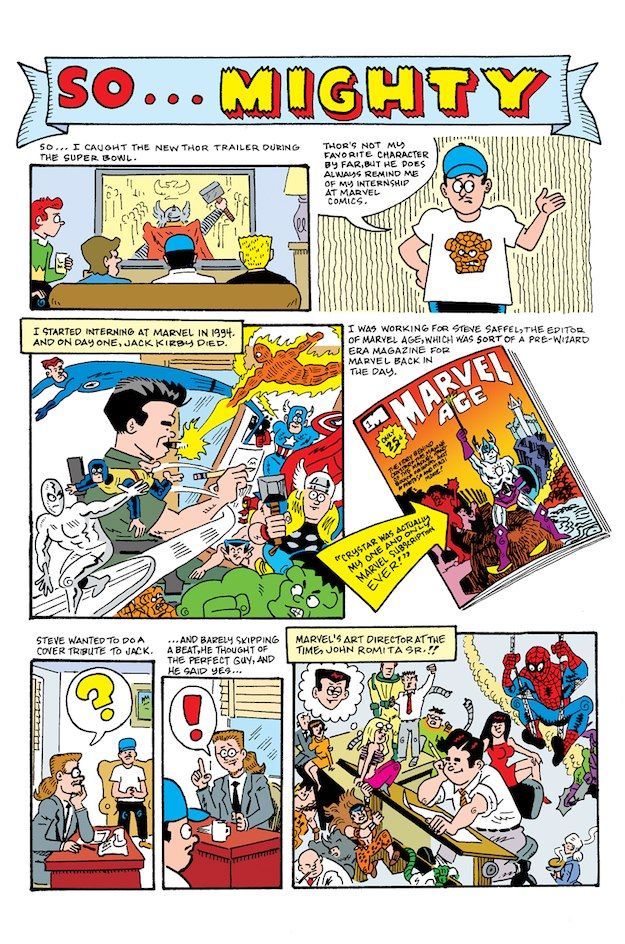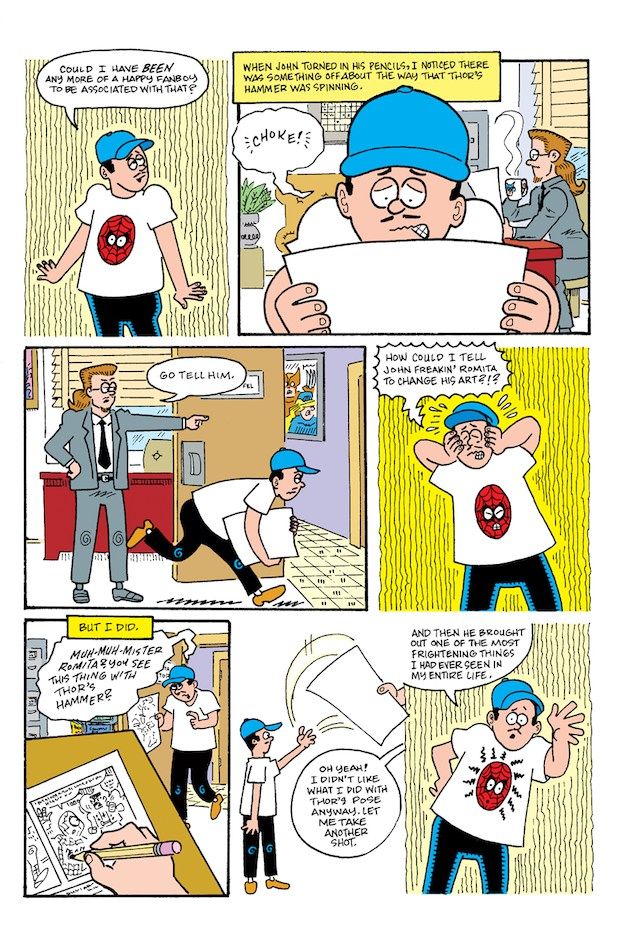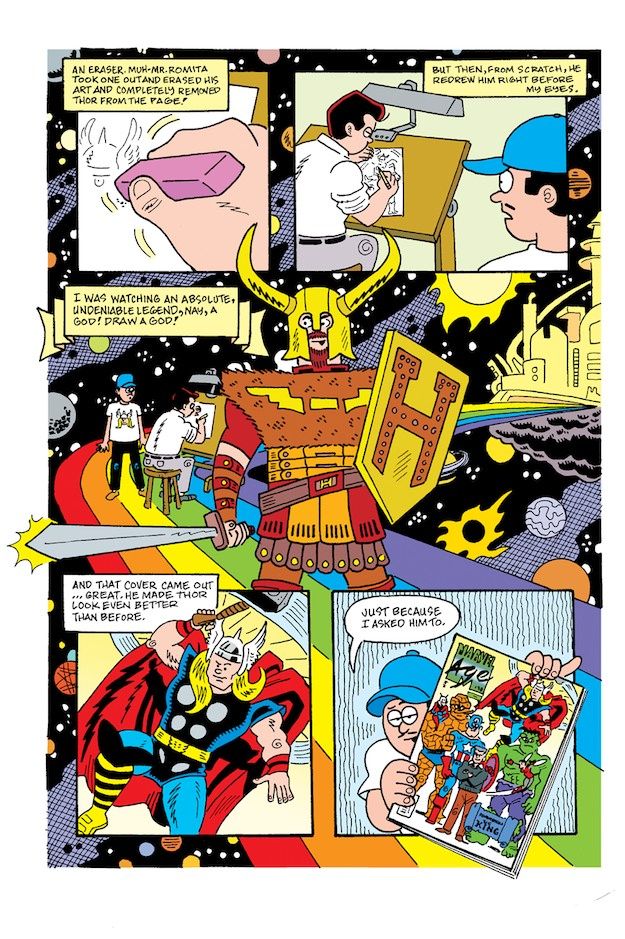Jonathan Baylis recently published the seventh issue of his annual minicomic So Buttons, a collection of short, autobiographical stories, written by Baylis and illustrated by a variety of artists. They range from lighthearted anecdotes about his years in the comics and entertainment business (he started an internship at Marvel the day Jack Kirby died, and later worked for Valiant and Topps) to heartfelt stories about discovering beauty, confronting death and fighting his inner demons.
I first met Baylis (as he correctly remembers in this interview) last year a the Toronto Comic Arts Festival, although I was reading So Buttons before that. We have kept in touch since then, and it's always a pleasure to run into him at a show. When he told me that So Buttons #7 was about to go live on comiXology, it seemed like an opportune moment for an interview about his work and his experiences as a minicomics creator. He not only answered my questions with gusto, he sent along a ton of art and a full-length So Buttons story about an encounter with John Romita Sr. (below).
Brigid Alverson: How did you hit on the idea of doing an anthology of short autobiographical comics?
Jonathan Baylis: So … it didn’t start that way. What happened was I discovered this newspaper in Greenwich Village called Free Comics NYC. Turns out that was their first issue and they printed a wide variety of short comic stories, and I thought, “I bet I could do something like this!” I had a co-worker friend, Mr. Alan, that had graduated from the School of Visual Arts in NYC and had done some comics work. I came up with a little four-pager about my dad that he illustrated and we submitted, and lo and behold, we got into the paper! That publication quickly folded after (not my fault!), but that’s what launched the beginning of So Buttons.
Soon after, I noticed another local publication called The Comical that was about the stand-up comedy scene in NYC. They were reprinting old Pekar one-pagers, and I offered them a new, original strip about dating a comedian (now my wife Ophira) and they bit! Then I was accepted into a couple of literary anthologies like The Florida Review and Wild River Review, and it was becoming kind of a habit. But I still wasn’t sure that this was really going to be … a thing.
I decided to collect the stories into one volume, and I thought that might be it. But then I had these other ideas and my artists were still interested in indulging me (paying them helps, ha!). So then I published another issue. And another. And I’ve basically put out one issue a year of varying lengths now for seven years. Totally unexpected.
Not everybody's life divides up neatly into story arcs. How do you deal with this? Do you ever bend the truth to fit a story?
I feel like that’s almost a question about how I decide which stories to do? My wife, who tells stories professionally, would say that some of my tales are anecdotes and some are stories. I think I might be aiming more for stories these days, which means a beginning, middle and end with some life-altering moment, be it big or small. I like good anecdotes, like Harvey Pekar’s Mr. Boats pieces, but I think my naturally corny nature tends towards a more “The Moth” approach with some kind of life lesson or something, ha!
What I do isn’t really diary comics (which I love, like Sam Spina’s or Gabrielle Bell’s), so I’m not trying to come up with an arc every day or week. I curate moments from life that I might tell verbally if it strikes me, so I don’t have to force a panel #4 gag or something. I percolate moments that I feel can resonate into a complete whole without forcing the truth or bending the truth. That said, I’m gonna go with 95 percent of it is true, with some artistic license tweaking to make it feel right, ha!
How do the people around you feel about being portrayed in your comics? How do you deal with potential hurt feelings?
I feel like my goal is to make auto-bio comics that are the antidote to woe-is-me, complainy kind-of comics, so there’s not a lot of hurt feelings in my work. I’m aiming for the funny or the positive. I’m not trying to go for the jugular really. I might tease my wife a little, but she jabs me from the stand-up stage, so that’s OK. Even-steven. I might touch upon my childhood bullying, but it’s not like I’m calling them out by name and condemning them for life or anything. (I’ve secretly had them whacked anyway.)
And what about yourself? Sometimes you don't cast yourself in the most flattering light. Why do you think it's important to show us your flaws?
I think I’m human. We’re all human, except for Noah Van Sciver, who’s some sort of robot-machine comix genius.
And to be human is to be REALLY FLAWED. I have so many of them. I can be vain and envious and petty and cheap and pretentious, yadda yadda. And if I’m gonna try to be relatively positive in general, then I should certainly take the piss out of myself. Maybe part of it is my growing up with Dave Letterman and self-deprecation.
How do you go about writing a story? I'm always interested in how writers and artists work together. Do you know who the artist will be before you start? Do you write in a particular way for particular artists?
First of all, I love collaboration. My day job is collaboration. I write and produce promos for USA Network, so I work with directors, editors, audio engineers, voiceover artists, etc., and I love the magic that can happen when we all build on top of each other.
Sometimes my stories are birthed fully, like Athena exploding out of Zeus’ skull. I have a thought, I start writing, and it’s basically done in day. Like I’m sure my Robert-Redford-is-a-douche story, “So/undance” was like that. But others, like “So … Embarrassed” was one of the first things I worked on, but didn’t get completed until 10 years later because I’d add something then leave it. Return to it and tweak something else. And leave it, etc.
As far as the artists, that’s an interesting journey. When I write, I do tend to think of certain artists in mind. And sometimes, I get who I’d like and I’ve already written to their strengths. Like I had wanted to work with Becky Hawkins, who told me she liked architecture, so I wrote something that involved Frank Gehry’s amazing Bilbao Guggenheim Museum for her and it’s one of my all time favorites because I felt like she really put her all into it and might be one of her best works.
But other times, I can get refused, which is totally ok, and I wind up tweaking the piece to sculpt it to what I think a different artist would like to draw.
I have a couple of stories right now that I’m writing. One is a dog/pet story I’m aiming for Rachel Dukes. Another is a Lone Wolf and Cub thing that I’m trying to emulate for Eric Kim. And one that I’ve been working on forever for my longest and most dedicated partner, T.J. Kirsch.
As far as process, I tend to write using the same format. Nothing particularly special. I number the panels, and generally describe what’s going on in the panel, but try to leave some room for artistic license. Under that I write the captions and word balloons. Occasionally I’ll include links or pics for reference if I have it. But even though I lay out as much as possible, I’m always open to the artist having their own ideas as far as number of panels or layouts. I want them to feel like they have the freedom to be as creative as possible. I think it’s created some really nice results! “Happy accidents,” as they often say in film and TV.
Have you ever tried to do your own art?
When I was a kid, I would copy. I would find a cover of a comic, like Swamp Thing #28 by Steve Bissette or Kirby’s Demon #9, and do my best to copy it into a sketchbook. But I was never really inspired to draw from my own mind and take the 10,000 hours to hone some drawing skills. This is why it’s so important that I PAY every artist I work with. I understand how hard it is to do what they do and they deserve to be rewarded for it as best I can.
It’s not that I can’t draw, really. It’s that I love how many different styles I can get out of the people I work with, and I love to pay them to do it.
What were your goals for So Buttons when you started out, and how have they evolved?
I think I just wanted to come out with that first issue and see what happened. Say that I did it. I remember exhibiting at MoCCA in that new Armory space. I shared a table with Joey Manley, who’s now passed, and sat across the aisle from Lucy Knisley, whose work I adore. And I sold six books. Maybe that was it. For good.
But then there were more nagging stories that came out. So the next goal was to come out with one book a year for a couple of years, and I’ve done it for seven. And I can sell more than six books at a show. Now the goal is to come out with a collection and maybe I’ll be done. But who knows? I have a full-length semi-auto-bio graphic biography memoir thing that I’ve been poking at for a while.
I think if I were to really go deep, I think comix has enabled me to fully embrace a certain side of myself that was bullied my whole life. And the cons that I go to are fights. Fights against my past for that side of myself to be accepted. At conventions I have this kind of extrovert exterior, but I’m really just an introvert in disguise and feel like a total unworthy slob to people that I’m friendly with and respect and admire at cons like Noah and Ed Piskor and Julia Wertz and Box Brown. I think I seek more approval than sales, which is probably not healthy, but that’s what it is.
So maybe my real goal is to just finally chill out and feel like one of the gang. But it’s hard when I’m just a dinky writer and everyone else is a full-on creator. Only Pekar can be Pekar, maybe?
Why do you like the minicomics format, rather than longer collections?
For years, I’ve been thinking in small bites. So the mini-comics format fits that mindset perfectly. Also, I’ve always had access to a good copier at work, ha!
But I’ve had a kind of VERY loose 10-year plan where I write that longer graphic memoir. But only if this future collection of So Buttons seems to hit in any kind of bigger way than my individual minis have I guess.
I'm guessing you don't make your living from So Buttons. How do you fit in your comics activities with the demands of your day job? Would you like to be a full-time comics creator some day, or would you prefer not to?
You’ve guessed accurately! As I said above, I work in cable TV, which I love, but is precariously in flux at the moment as millennials choose to watch something other than cable, like Vines and Instagram. Floobidy-floob, I’m an old man!
It’s not hard to fit in one book a year when we’re only talking between 12 and 30-some odd pages. It’s not much. Folks at work tend to like what I’m doing and support it, which is nice. USA Network is the nicest place I’ve ever worked.
As far as full-time? That doesn’t really seem like a thing, right? Does anyone do these kinds of comics full-time? Maybe those big guys like Chris Ware and Dan Clowes who also draw New Yorker covers and sell original art for thousands of dollars. But for me, I feel like that would be almost too much pressure to just come out with a volume of material. I mean, I guess Alison Bechdel’s not churning them out one every six months, so if “full-time” meant that I’d come out with a great book every five years, I’d be cool with that, but I imagine that some day job would have to be involved.
Will you be doing a collected edition — the So Buttons Compendium, maybe?
YES!!! Now that I have some seven-odd issues with well over 100 pages of material, I want to collect it! I’ve already had Dean Haspiel draw a cover for it, based on an old lobby card from a movie called “Man of a Thousand Faces," but mine’s more like a dozen faces with the quantity of artists I’ve worked with. I’m just trying to figure out my plan. Approach a small press publisher, like Alternative Comics? Get rejected by bigger folks like Fantagraphics and Drawn and Quarterly? Do a Kickstarter raise funds, promote and self-publish? Who knows? But I will be printing that sucker somehow, some way.
Where do you sell your comics? That sounds so mercenary — what I really mean is, where do people discover them?
For physical copies, I have three means. I have a minicomics agent, Tony Shenton, who has successfully placed my books in fine shops in great towns all across America. I sell at conventions, of which I’ve been to a few, like SPX (which I consider my “home” con), MoCCA, and TCAF. And I sell directly online. I try to post complete stories on Twitter as often as I can, tweeting curated selects to people (or InterTubes robots) that follow me, but I don’t have a good gauge on how successful that really is. Are people reading them? Does that translate into sales somehow? Who knows?!
But one weird thing is that I was on the first season of Comic Book Men on AMC. They were really nice to me and complimentary of my book, which they’ve sold in their shop. And folks have seen that on Netflix and ordered every book I’ve ever published, so that’s a joy every time that happens.
How has going on comiXology changed that? What's your mix of digital to print? Do you use any other digital channels?
I’ve sold digital copies in a few places, but none as successful as on comiXology, which has been a really positive experience. Chip Mosher [...] used to staple Shannon Wheeler’s minicomics back in the day, so I appreciate that he digs small press.
So far, I sell every fiscal quarter what I’d sell at one, or sometimes two, days at a con. So it’s nice. I just want folks to read and appreciate the stories. It’s not about the money at all.
I’ve tried a couple of other digital channels like iVerse and Pulp, but none as successful as comiXology. Not even close. But I still root for them!
What shows do you go to, and why do you like them?
Like I said, I consider SPX my home show. I’ve exhibited there six years in a row, I think. There’s something about exhibiting where you sleep (AND DRINK) and seeing folks you love and admire every single year, including comics reporters like yourself and Rob Clough, Heidi MacDonald, Calvin Reid, Johanna Draper Carlson, Tom Spurgeon, etc., etc.
TCAF was amazing the one year I went. My wife is Canadian, so I have a great love for Canada and hope to be invited back another year. The energy at that show is incredible. I think that’s where I first met you, Brigid!
MoCCA has been a roller coaster. The first couple of years I exhibited were like 110 degrees in the Armory. Sometimes sales were OK, other times, not great. I haven’t been there since the Illustrators have taken over. I would’ve liked to have seen that Charlie Brown balloon. That sounded like a fun idea.
I not sure I have a good idea what’s worked as far as promotion. I don’t know if reviews have really gotten me sales. Or if my tweeting has helped. I’m dying to see the results of a promotion that comiXology executed after SPX. The only direct response I’m confident I understand is people that buy my books after seeing my appearance on Comic Book Men on Netflix.
I feel like a fogie compared to most indie folks. Like, I’m 10 years older than most people in the game at my level. And maybe they have a better grasp of contemporary grassroots marketing that I don’t have. I would love for someone to give me any advice or information how to create more readers and sales besides trying to create good stories and hoping people like them and spread the love.
But maybe this is one way! Plug time!
For a 99 cent digital copy of So Buttons, please visit comiXology.
Or, go to my website (sobuttons.com) and email me and I’ll send you any physical book you want for 99 cents plus shipping. How about that?
Here's a story from So Buttons #4: "So … Mighty," illustrated by Fred Hembeck.

